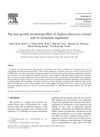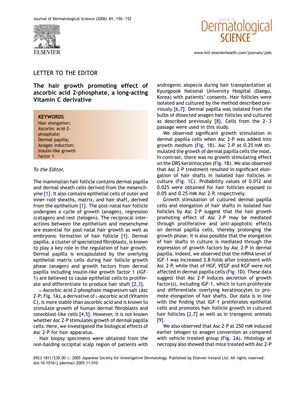TLDR A long-acting Vitamin C derivative helps hair grow by stimulating cells and increasing growth factors.
In the 2006 study, researchers investigated the effects of ascorbic acid 2-phosphate (Asc 2-P), a stable derivative of Vitamin C, on hair growth. They found that Asc 2-P significantly stimulated the growth of dermal papilla cells and promoted the elongation of hair shafts in isolated hair follicles cultured in vitro. The most effective concentration of Asc 2-P for dermal papilla cell growth was 0.25 mM, but it did not stimulate growth in outer root sheath (ORS) keratinocytes. Additionally, Asc 2-P treatment increased the mRNA level of insulin-like growth factor 1 (IGF-1) by 3.8-fold in dermal papilla cells, suggesting that Asc 2-P may induce the secretion of growth factors that proliferate and differentiate keratinocytes, leading to hair shaft elongation. In an animal model, Asc 2-P at 250 mM induced an earlier transition from the telogen phase to the anagen phase of the hair cycle. These findings suggest that Vitamin C or its derivatives could play a role in regulating mesenchymal-epithelial interactions in the hair follicle, potentially offering a new approach to treating hair growth disorders.
 277 citations
,
June 2003 in “The journal of investigative dermatology. Symposium proceedings/The Journal of investigative dermatology symposium proceedings”
277 citations
,
June 2003 in “The journal of investigative dermatology. Symposium proceedings/The Journal of investigative dermatology symposium proceedings” Epithelial-mesenchymal interactions control hair growth cycles through specific molecular signals.
 75 citations
,
October 2002 in “Journal of Dermatological Science”
75 citations
,
October 2002 in “Journal of Dermatological Science” Sophora flavescens extract may help hair grow by affecting growth factors and blocking a hair-related enzyme.
 78 citations
,
August 2002 in “Experimental Dermatology”
78 citations
,
August 2002 in “Experimental Dermatology” Researchers developed a quick and easy way to get and grow cells from the base of human hair follicles.
173 citations
,
July 1995 in “Biochemical and biophysical research communications” Male hormones promote hair cell growth by using a growth factor from nearby skin cells.
385 citations
,
November 1990 in “Journal of Cell Science” Human hair follicles can grow in a lab setting.
 10 citations
,
February 2016 in “Journal of Dermatological Science”
10 citations
,
February 2016 in “Journal of Dermatological Science” Skin sheath cells help in hair growth and renewal after birth.
95 citations
,
July 2006 in “British Journal of Dermatology” Vitamin D receptors in hair follicles change with the hair cycle, affecting hair growth.
 277 citations
,
June 2003 in “The journal of investigative dermatology. Symposium proceedings/The Journal of investigative dermatology symposium proceedings”
277 citations
,
June 2003 in “The journal of investigative dermatology. Symposium proceedings/The Journal of investigative dermatology symposium proceedings” Epithelial-mesenchymal interactions control hair growth cycles through specific molecular signals.
154 citations
,
October 1996 in “Proceedings of the National Academy of Sciences of the United States of America” Estrogen affects hair growth and skin cell multiplication.




